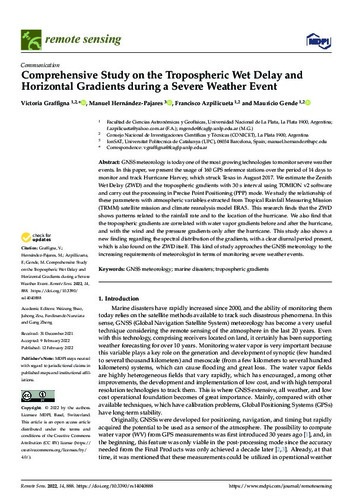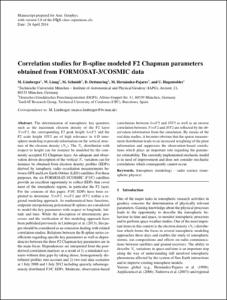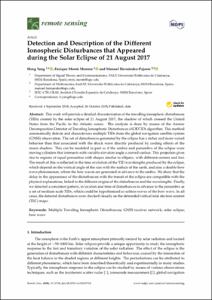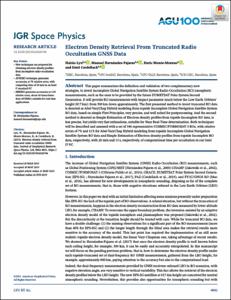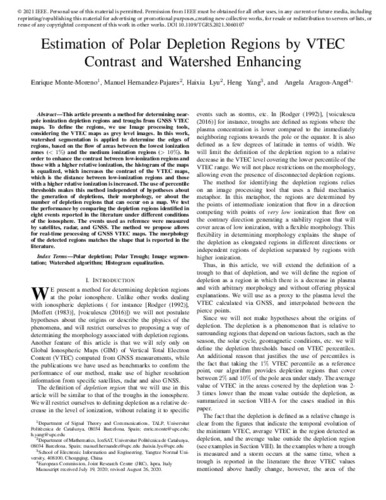Exploració per autor "Hernández Pajares, Manuel"

Ara es mostren els items 21-40 de 202
-
Comments on: confirming geomagnetic Sfe by means of a solar flare detector based on GNSS

Hernández Pajares, Manuel; García Rigo, Alberto (2020-01-01)
Hernández Pajares, Manuel; García Rigo, Alberto (2020-01-01)
Article
Accés obertWe report two comments affecting the paper “Curto JJ, Juan JM & Timoté CC, 2019. Confirming geomagnetic Sfe by means of a solar flare detector based on GNSS. J Space Weather Space Clim 9: A42. https://doi.org/10.1051/sws ... -
Comparative testing of four ionospheric models driven with GPS measurements

Zandbergen, R.; Feltens, Joachim; Angling, M; Jackson Booth, N; Jakowski, Norbert; Hoque, Mainul; Hernández Pajares, Manuel; Aragón Ángel, María Ángeles; Orús Pérez, Raül (2011-07-28)
Zandbergen, R.; Feltens, Joachim; Angling, M; Jackson Booth, N; Jakowski, Norbert; Hoque, Mainul; Hernández Pajares, Manuel; Aragón Ángel, María Ángeles; Orús Pérez, Raül (2011-07-28)
Article
Accés obertIn the context of the European Space Agency/European Space Operations Centre funded Study “GNSS Contribution to Next Generation Global Ionospheric Monitoring,” four ionospheric models based on GNSS data (the Electron ... -
Comparing performances of seven different global VTEC ionospheric models in the IGS context

Hernández Pajares, Manuel; Roma Dollase, David; Krankowski, Andrzej; García Rigo, Alberto; Orús Pérez, Raul (International GNSS Service (IGS), 2016)
Hernández Pajares, Manuel; Roma Dollase, David; Krankowski, Andrzej; García Rigo, Alberto; Orús Pérez, Raul (International GNSS Service (IGS), 2016)
Text en actes de congrés
Accés restringit per política de l'editorialA summary of the main concepts on Global Ionospheric Map(s) (hereinafter GIM(s)) of Vertical Electron Content (VTEC), with special emphasis on their assessment, is presented in this paper. It is based on the experience ... -
Comprehensive ionospheric delay modelling for single-frequency GNSS precise positioning: first steps

Colombo, Oscar L.; Hernández Pajares, Manuel; Janssen, Volker; García Rigo, Alberto (International GNSS Service (IGS), 2016)
Colombo, Oscar L.; Hernández Pajares, Manuel; Janssen, Volker; García Rigo, Alberto (International GNSS Service (IGS), 2016)
Comunicació de congrés
Accés restringit per política de l'editorial -
Comprehensive study on the tropospheric Wet Delay and horizontal gradients during a severe weather event

Graffigna, Victoria; Hernández Pajares, Manuel; Azpilicueta, Francisco; Gende, Mauricio (Multidisciplinary Digital Publishing Institute (MDPI), 2022-02-12)
Graffigna, Victoria; Hernández Pajares, Manuel; Azpilicueta, Francisco; Gende, Mauricio (Multidisciplinary Digital Publishing Institute (MDPI), 2022-02-12)
Article
Accés obertGNSS meteorology is today one of the most growing technologies to monitor severe weather events. In this paper, we present the usage of 160 GPS reference stations over the period of 14 days to monitor and track Hurricane ... -
Consistency of seven different GNSS global ionospheric mapping techniques during one solar cycle

Roma Dollase, David; Hernández Pajares, Manuel; Krankowski, Andrzej; Kotulak, Kacper; Ghoddousi Fard, Reza; Yuan, Yunbin; Li, Zishen; Zhang, Hongping; Shi, Chuang; Wang, Cheng; Feltens, Joachim; Vergados, Panagiotis; Komjathy, Attila; Schaer, Stefan C.; García Rigo, Alberto; Gómez Cama, José Mª (2018-06)
Roma Dollase, David; Hernández Pajares, Manuel; Krankowski, Andrzej; Kotulak, Kacper; Ghoddousi Fard, Reza; Yuan, Yunbin; Li, Zishen; Zhang, Hongping; Shi, Chuang; Wang, Cheng; Feltens, Joachim; Vergados, Panagiotis; Komjathy, Attila; Schaer, Stefan C.; García Rigo, Alberto; Gómez Cama, José Mª (2018-06)
Article
Accés obertIn the context of the International GNSS Service (IGS), several IGS Ionosphere Associated Analysis Centers have developed different techniques to provide global ionospheric maps (GIMs) of vertical total electron content ... -
Correlation studies for B-spline modeled F2 Chapman parameters obtained from FORMOSAT-3/COSMIC data

Limberger, Marco; Liang, W; Schmidt, Michael; Dettmering, D; Hernández Pajares, Manuel; Hugentobler, U (2014)
Limberger, Marco; Liang, W; Schmidt, Michael; Dettmering, D; Hernández Pajares, Manuel; Hugentobler, U (2014)
Article
Accés obertThe determination of ionospheric key quantities such as the maximum electron density of the F2 layer NmF2, the corresponding F2 peak height hmF2 and the F2 scale height HF2 are of high relevance in 4-D ionosphere modeling ... -
Critical issues in ionospheric data quality and implications for scientific studies

Araujo-Pradere, E.; Weatherhead, E. C.; Dandenault, P. B.; Bilitza, D.; Wilkinson, P.; Hernández Pajares, Manuel (2019-05)
Araujo-Pradere, E.; Weatherhead, E. C.; Dandenault, P. B.; Bilitza, D.; Wilkinson, P.; Hernández Pajares, Manuel (2019-05)
Article
Accés obertIonospheric data are valuable records of the behavior of the ionosphere, solar activity, and the entire Sun-Earth system. The data are critical for both societally important services and scientific investigations of upper ... -
Definition of an SBAS ionospheric activity indicator and its assessment over Europe and Africa During the last solar cycle

Sanz Subirana, Jaume; Juan Zornoza, José Miguel; Hernández Pajares, Manuel; Prieto Cerdeira, Roberto; Schlueter, Stefan (2013)
Sanz Subirana, Jaume; Juan Zornoza, José Miguel; Hernández Pajares, Manuel; Prieto Cerdeira, Roberto; Schlueter, Stefan (2013)
Comunicació de congrés
Accés restringit per política de l'editorialIn this work, an ionospheric activity indicator is defined based in the “weighted” Along Arc TEC rate (AATR). It is shown that this indicator, which can be easily computed from the GPS carrier phases, is well correlated ... -
Detection and description of the different ionospheric disturbances that appeared during the solar eclipse of 21 August 2017

Yang, Heng; Monte Moreno, Enrique; Hernández Pajares, Manuel (Multidisciplinary Digital Publishing Institute (MDPI), 2018-10-30)
Yang, Heng; Monte Moreno, Enrique; Hernández Pajares, Manuel (Multidisciplinary Digital Publishing Institute (MDPI), 2018-10-30)
Article
Accés obertThis work will provide a detailed characterization of the travelling ionospheric disturbances (TIDs) created by the solar eclipse of 21 August 2017, the shadow of which crossed the United States from the Pacific to the ... -
Direct determination of electron density profiles from GNSS occulttion data

Aragón Ángel, María Ángeles; Hernández Pajares, Manuel; Miguel Juan, Miguel; Sanz Subirana, Jaume; Ramos Bosch, Pedro (2008-08-07)
Aragón Ángel, María Ángeles; Hernández Pajares, Manuel; Miguel Juan, Miguel; Sanz Subirana, Jaume; Ramos Bosch, Pedro (2008-08-07)
Comunicació de congrés
Accés obert -
Direct MSTID mitigation in precise GPS processing

Hernández Pajares, Manuel; Wielgosz, Pawel; Paziewski, Jacek; Krypiak-Gregorczyk, Anna; Krukowska, Marta; Stepniak, Katarzyna; Kaplon, Jan; Hadas, Tomasz; Sosnica, Krzysztof; Bosy, Jaroslaw; Orús Pérez, Raul; Monte Moreno, Enrique; Yang, Heng; García Rigo, Alberto; Olivares Pulido, Germán (2017-03)
Hernández Pajares, Manuel; Wielgosz, Pawel; Paziewski, Jacek; Krypiak-Gregorczyk, Anna; Krukowska, Marta; Stepniak, Katarzyna; Kaplon, Jan; Hadas, Tomasz; Sosnica, Krzysztof; Bosy, Jaroslaw; Orús Pérez, Raul; Monte Moreno, Enrique; Yang, Heng; García Rigo, Alberto; Olivares Pulido, Germán (2017-03)
Article
Accés obertIn this paper, the authors summarize a simple and efficient approach developed to mitigate the problem in precise GNSS positioning originated by the most frequent ionospheric wave signatures: the Medium Scale Travelling ... -
Distribution and mitigation of higher-order ionospheric effects on precise GNSS processing

Hernández Pajares, Manuel; Aragón Ángel, María Ángeles; Defraigne, Pascale; Bergeot, Nicolas; Prieto Cerdeira, Roberto; García Rigo, Alberto (2014-04)
Hernández Pajares, Manuel; Aragón Ángel, María Ángeles; Defraigne, Pascale; Bergeot, Nicolas; Prieto Cerdeira, Roberto; García Rigo, Alberto (2014-04)
Article
Accés obertHigher-order ionospheric effects (I2+) are one of the main limiting factors in very precise Global Navigation Satellite Systems (GNSS) processing, for applications where millimeter accuracy is demanded. This paper summarizes ... -
Electron density extrapolation above F2 peak by the linear Vary-Chap model supporting new Global Navigation Satellite Systems-LEO occultation missions

Hernández Pajares, Manuel; García Fernández, Miquel; Rius Carrasco, Antoni; Notarpietro, Riccardo; von Engeln, Axel; Olivares Pulido, Germán; Aragón Ángel, Maria Angeles; García Rigo, Alberto (2017-08)
Hernández Pajares, Manuel; García Fernández, Miquel; Rius Carrasco, Antoni; Notarpietro, Riccardo; von Engeln, Axel; Olivares Pulido, Germán; Aragón Ángel, Maria Angeles; García Rigo, Alberto (2017-08)
Article
Accés obertThe new radio-occultation (RO) instrument on board the future EUMETSAT Polar System-Second Generation (EPS-SG) satellites, flying at a height of 820 km, is primarily focusing on neutral atmospheric profiling. It will also ... -
Electron density retrieval from truncated Radio Occultation GNSS data

Lyu, Haixia; Hernández Pajares, Manuel; Monte Moreno, Enrique; Cardellach Galí, Estel (2019-06-01)
Lyu, Haixia; Hernández Pajares, Manuel; Monte Moreno, Enrique; Cardellach Galí, Estel (2019-06-01)
Article
Accés obertThis paper summarizes the definition and validation of two complementary new strategies, to invert incomplete Global Navigation Satellite System Radio-Occultation (RO) ionospheric measurements, such as the ones to be ... -
Enhanced precise point positioning for GNSS users

Juan Zornoza, José Miguel; Hernández Pajares, Manuel; Sanz Subirana, Jaume; Ramos Bosch, Pedro; Aragón Ángel, María Ángeles; Orus, R.; Ochieng, W.; Feng, S; Jofre, Martí; Coutinho, P; Samson, Jaron; Tossaint, Michel Mathias Maria (Institute of Electrical and Electronics Engineers (IEEE), 2012-09-21)
Juan Zornoza, José Miguel; Hernández Pajares, Manuel; Sanz Subirana, Jaume; Ramos Bosch, Pedro; Aragón Ángel, María Ángeles; Orus, R.; Ochieng, W.; Feng, S; Jofre, Martí; Coutinho, P; Samson, Jaron; Tossaint, Michel Mathias Maria (Institute of Electrical and Electronics Engineers (IEEE), 2012-09-21)
Article
Accés restringit per política de l'editorialThis paper summarizes the main results obtained during the development of an Enhanced Precise Point Positioning (EPPP) Global Navigation Satellite Systems multifrequency user algorithm. The main innovations include the ... -
Estimation of polar depletion regions by VTEC contrast and watershed enhancing

Monte Moreno, Enrique; Hernández Pajares, Manuel; Lyu, Haixia; Yang, Heng; Aragon-Angel, Angela (Institute of Electrical and Electronics Engineers (IEEE), 2022)
Monte Moreno, Enrique; Hernández Pajares, Manuel; Lyu, Haixia; Yang, Heng; Aragon-Angel, Angela (Institute of Electrical and Electronics Engineers (IEEE), 2022)
Article
Accés obertThis article presents a method for determining near-Pole ionization depletion regions and troughs from global navigation satellite system (GNSS) vertical total electron content (VTEC) maps. To define the regions, we use ... -
EVA: GPS-based extended velocity and acceleration determination

Salazar Hernández, Dagoberto José; Hernández Pajares, Manuel; Juan Zornoza, José Miguel; Sanz Subirana, Jaume; Aragón Ángel, María Ángeles (2010-12-01)
Salazar Hernández, Dagoberto José; Hernández Pajares, Manuel; Juan Zornoza, José Miguel; Sanz Subirana, Jaume; Aragón Ángel, María Ángeles (2010-12-01)
Article
Accés restringit per política de l'editorialIn this work, a new GPS carrier phase-based velocity and acceleration determination method is presented that extends the effective range of previous techniques. The method is named ‘EVA’, and may find applications in ... -
Evaluation of the ionospheric F2 characteristics inferred from radio occultations exploiting the availability of FORMOSAT-3/COSMIC data over half a solar cycle

Aragón Ángel, Maria Angeles; Limberger, Marco; Hernández Pajares, Manuel; Altadill, David; Erdogan, Eren; Schmidt, Michael (ION Publications (The Institute of navigation), 2016)
Aragón Ángel, Maria Angeles; Limberger, Marco; Hernández Pajares, Manuel; Altadill, David; Erdogan, Eren; Schmidt, Michael (ION Publications (The Institute of navigation), 2016)
Text en actes de congrés
Accés restringit per política de l'editorialThis contribution presents the assessment, on both the maximum electron density (NmF2) and the corresponding peak height of the F2 layer (hmF2), of the overall performance of such ionospheric key parameters inferred from ... -
Extended version. Occurrence of solar flares viewed with GPS: statistics and fractal nature

Monte Moreno, Enrique; Hernández Pajares, Manuel (2014-09-05)
Monte Moreno, Enrique; Hernández Pajares, Manuel (2014-09-05)
Report de recerca
Accés restringit per política de l'editorialIn this paper we describe the statistical properties of the EUV solar flux sudden variation. The solar flux variation is modeled as a time series characterized by the subsolar VTEC (Vertical Total Electron Content) ...




